Synthesis, Characterization, and Antibacterial Assessment (Synergism) of Silver Nanoparticles Prepared with Stem Bark Extract of Sterculia diversifolia
(This article belongs to the Section Inorganic Crystalline Materials)
Abstract
1. Introduction
2. Materials and Methods
2.1. Materials
2.2. Plant Collection and Taxonomic Identification
2.3. Preparation of Extract
2.4. Samples collection
2.5. Isolation and Identification
2.6. Gram Staining
2.7. Antibacterial Activity of Crude Extracts against S. aureus and P. aeruginosa
2.8. Synthesis of Silver Nanoparticles
2.9. Characterization of AgNPs
2.10. Preparation of AgNP-Coated Antibiotic Discs
2.11. Disc Diffusion Assay
2.12. Ethical Statement
2.13. Statistical Analysis
3. Results
3.1. Synthesis of Silver Nanoparticles
3.2. Characterization of Nanoparticles
3.2.1. UV-Vis Spectroscopic Confirmation
3.2.2. Scanning Electron Microscopy and Transmission Electron Microscopy
3.2.3. X-ray Diffraction Method
3.2.4. FTIR Analysis
3.3. Isolation and Identification of Bacterial Species
3.4. Antibacterial Activity of AgNPs
3.5. Anti-Bacterial Activity of S. diversifolia Stem Bark Crude Extract against Staphylococcus aureus
3.6. Anti-Bacterial Activity of S. diversifolia Stem Crude Extract against P. aeruginosa
4. Discussion
5. Conclusions
Author Contributions
Funding
Data Availability Statement
Acknowledgments
Conflicts of Interest
References
- Guan, Z.; Ying, S.; Ofoegbu, P.C.; Clubb, P.; Rico, C.; He, F.; Hong, J. Green synthesis of nanoparticles: Current developments and limitations. Environ. Technol. Innov. 2022, 26, 102336. [Google Scholar]
- Gong, D.; Sun, L.; Li, X.; Zhang, W.; Zhang, D.; Cai, J. Micro/Nanofabrication, Assembly, and Actuation Based on Microorganisms: Recent Advances and Perspectives. Small Struct. 2023, 4, 2200356. [Google Scholar] [CrossRef]
- Mubayi, A.; Chatterji, S.; K Rai, P.; Watal, G. Evidence based green synthesis of nanoparticles. Adv. Mater. Lett. 2012, 3, 519–525. [Google Scholar] [CrossRef]
- Guo, Y.; Sun, Q.; Wu, F.G.; Dai, Y.; Chen, X. Polyphenol-containing nanoparticles: Synthesis, properties, and therapeutic delivery. Adv. Mater. 2021, 33, 2007356. [Google Scholar] [CrossRef]
- Kesharwani, J.; Yoon, K.Y.; Hwang, J.; Rai, M. Phytofabrication of silver nanoparticles by leaf extract of Datura metel: Hypothetical mechanism involved in synthesis. J. Bionanosci. 2009, 3, 39–44. [Google Scholar] [CrossRef]
- Das, R.K.; Pachapur, V.L.; Lonappan, L.; Naghdi, M.; Pulicharla, R.; Maiti, S.; Cledon, M.; Dalila, L.M.A.; Sarma, S.J.; Brar, S.K. Biological synthesis of metallic nanoparticles: Plants, animals and microbial aspects. Nanotechnol. Environ. Eng. 2017, 2, 18. [Google Scholar] [CrossRef]
- Bankier, C.; Matharu, R.; Cheong, Y.; Ren, G.; Cloutman-Green, E.; Ciric, L. Synergistic antibacterial effects of metallic nanoparticle combinations. Sci. Rep. 2019, 9, 16074. [Google Scholar] [CrossRef]
- He, M.; Wang, Q.; Wang, R.; Xie, Y.; Zhao, W.; Zhao, C. Design of antibacterial poly (ether sulfone) membranes via covalently attaching hydrogel thin layers loaded with Ag nanoparticles. ACS Appl. Mater. Interface 2017, 9, 15962–15974. [Google Scholar] [CrossRef]
- Karimi-Maleh, H.; Kumar, B.G.; Rajendran, S.; Qin, J.; Vadivel, S.; Durgalakshmi, D.; Gracia, F.; Soto-Moscoso, M.; Orooji, Y.; Karimi, F. Tuning of metal oxides photocatalytic performance using Ag nanoparticles integration. J. Mol. Liq. 2020, 314, 113588. [Google Scholar] [CrossRef]
- Khandel, P.; Yadaw, R.K.; Soni, D.K.; Kanwar, L.; Shahi, S.K. Biogenesis of metal nanoparticles and their pharmacological applications: Present status and application prospects. J. Nanostructure Chem. 2018, 8, 217–254. [Google Scholar] [CrossRef]
- Kanwal, H.; Sherazi, B.A. Herbal medicine: Trend of practice, perspective, and limitations in Pakistan. Asian Pac. J. Health Sci. 2017, 4, 6–8. [Google Scholar] [CrossRef]
- Vasisht, K.; Sharma, N.; Karan, M. Current perspective in the international trade of medicinal plants material. Curr. Pharm. Des. 2016, 22, 4288–4336. [Google Scholar] [CrossRef]
- Zucca, P.; Bellot, S.; Rescigno, A. The modern use of an ancient plant: Exploring the antioxidant and nutraceutical potential of the Maltese mushroom (Cynomorium Coccineum L.). Antioxidants 2019, 8, 289. [Google Scholar] [CrossRef]
- Ijaz, S.; Perveen, A.; Ashraf, S.; Bibi, A.; Dogan, Y. Indigenous wild plants and fungi traditionally used in folk medicine and functional food in District Neelum Azad Kashmir. Environ. Dev. Sustain. 2020, 23, 8307–8330. [Google Scholar] [CrossRef]
- Orisakeye, O.; Olugbade, T. Epicatechin and procyanidin B2 in the stem and root bark of Sterculia tragacantha Lindl (Sterculiaceae). Med. Chem. 2014, 4, 334–337. [Google Scholar]
- Ouédraogo, M.; Konate, K.; Zerbo, P.; Barro, N.; Sawadogo, L.L. Phytochemical Analysis and” in vitro” Antifungal Profile of Bioactive Fractions from” Sterculia setigera”(Sterculiaceae). Curr. Res. J. Biol. Sci. 2013, 5, 75–80. [Google Scholar] [CrossRef]
- Khatiashvili, N.; Gogilashvili, L.; Yarosh, E.; Kemertelidze, E. Lipids from Sterculia platanifolia and Hamamelis virginiana seeds. Chem. Nat. Compd. 2007, 43, 315–316. [Google Scholar] [CrossRef]
- Rabbi, F.; Zada, A.; Nisar, A.; Sohail, M.; Khalil, S.K.; Shah, W.A. Bioassay-Guided Isolation, Identification of Compounds from Sterculia diversifolia and Investigation of Their Anti-Glycation and Antioxidant Activities. Pharm. Chem. J. 2020, 53, 1137–1144. [Google Scholar] [CrossRef]
- Rabbi, F.; Zada, A.; Nisar, A. Larvicidal, leishmanicidal, insecticidal and anthelmintic effects of Sterculia diversifolia stem bark and leaf. Bangladesh J. Pharmacol. 2020, 15, 32–38. [Google Scholar] [CrossRef]
- Rabbi, F.; Zada, A.; Adhikari, A.; Jabeen, A.; Nisar, A.; Ullah, I. Sterculia diversifolia bears anti-cancer and immunomodulatory activities. Bangladesh J. Pharmacol. 2017, 12, 51–55. [Google Scholar] [CrossRef]
- Rabbi, F.; Zada, A.; Adhikari, A.; Nisar, A.; Khan, F.U.; Sohail, M.; Khalil, S.K.; Ghani, A.A. GC-MS analysis, metal analysis and antimicrobial investigation of sterculia diversifolia. Pharm. Chem. J. 2020, 54, 943–953. [Google Scholar] [CrossRef]
- Kolawole, O.; Makinde, J. Central nervous system depressant activity of Russelia equisetiformis. Niger. J. Physiol. Sci. 2007, 22, 59–63. [Google Scholar] [PubMed]
- Deng, H.; McShan, D.; Zhang, Y.; Sinha, S.S.; Arslan, Z.; Ray, P.C.; Yu, H. Mechanistic study of the synergistic antibacterial activity of combined silver nanoparticles and common antibiotics. Environ. Sci. Technol. 2016, 50, 8840–8848. [Google Scholar] [CrossRef] [PubMed]
- Salman, M.; Rizwana, R.; Khan, H.; Munir, I.; Hamayun, M.; Iqbal, A.; Rehman, A.; Amin, K.; Ahmed, G.; Khan, M. Synergistic effect of silver nanoparticles and polymyxin B against biofilm produced by Pseudomonas aeruginosa isolates of pus samples in vitro. Artif. Cells Nanomed. Biotechnol. 2019, 47, 2465–2472. [Google Scholar] [CrossRef]
- Ehsan, S.; Sajjad, M. Bioinspired synthesis of zinc oxide nanoparticle and its combined efficacy with different antibiotics against multidrug resistant bacteria. J. Biomater. Nanobiotechnol. 2017, 8, 2. [Google Scholar] [CrossRef]
- Ahmed, S.; Saifullah; Ahmad, M.; Swami, B.L.; Ikram, S. Green synthesis of silver nanoparticles using Azadirachta indica aqueous leaf extract. J. Radiat Res. Appl. Sci. 2016, 9, 843–850. [Google Scholar]
- Golkar, Z.; Bagasra, O.; Pace, D.G. Bacteriophage therapy: A potential solution for the antibiotic resistance crisis. J. Infect. Dev. Ctries. 2014, 8, 129–136. [Google Scholar] [CrossRef]
- Barlam, T.F.; Cosgrove, S.E.; Abbo, L.M.; MacDougall, C.; Schuetz, A.N.; Septimus, E.J.; Srinivasan, A.; Dellit, T.H.; Falck-Ytter, Y.T.; Fishman, N.O. Implementing an antibiotic stewardship program: Guidelines by the Infectious Diseases Society of America and the Society for Healthcare Epidemiology of America. Clin. Infect. Dis. 2016, 62, e51–e77. [Google Scholar] [CrossRef]
- McGuinness, W.A.; Malachowa, N.; DeLeo, F.R. Focus: Infectious diseases: Vancomycin resistance in Staphylococcus aureus. Yale J. Biol. Med. 2017, 90, 269. [Google Scholar]
- Selim, S.; Faried, O.A.; Almuhayawi, M.S.; Saleh, F.M.; Sharaf, M.; El Nahhas, N.; Warrad, M. Incidence of vancomycin-resistant Staphylococcus aureus strains among patients with urinary tract infections. Antibiotics 2022, 11, 408. [Google Scholar] [CrossRef]
- Mediati, D.G.; Wong, J.L.; Gao, W.; McKellar, S.; Pang, C.N.I.; Wu, S.; Wu, W.; Sy, B.; Monk, I.R.; Biazik, J.M. RNase III-CLASH of multi-drug resistant Staphylococcus aureus reveals a regulatory mRNA 3′ UTR required for intermediate vancomycin resistance. Nat. Commun. 2022, 13, 3558. [Google Scholar] [CrossRef]
- Sharma, G.; Rao, S.; Bansal, A.; Dang, S.; Gupta, S.; Gabrani, R. Pseudomonas aeruginosa biofilm: Potential therapeutic targets. Biologicals 2014, 42, 1–7. [Google Scholar] [CrossRef]
- Ruedas-López, A.; Alonso-García, I.; Lasarte-Monterrubio, C.; Guijarro-Sánchez, P.; Gato, E.; Vázquez-Ucha, J.C.; Vallejo, J.A.; Fraile-Ribot, P.A.; Fernández-Pérez, B.; Velasco, D. Selection of AmpC β-lactamase variants and metallo-β-lactamases leading to ceftolozane/tazobactam and ceftazidime/avibactam resistance during treatment of MDR/XDR Pseudomonas aeruginosa infections. Antimicrob. Agents Chemother. 2022, 66, e02067-21. [Google Scholar] [CrossRef]
- Fonseca, É.L.; Morgado, S.M.; Caldart, R.V.; Freitas, F.; Vicente, A.C.P. Emergence of a VIM-2-producing extensively drug-resistant (XDR) Pseudomonas aeruginosa ST309 in South America: A comparative genomic analysis. Inter. J. Antimicrob. Agents 2022, 59, 106507. [Google Scholar] [CrossRef]
- Nagajyoti, P.; TNVKV, P.; TVM, S.; Lee, K.D. Bio-fabrication of silver nanoparticles using leaf extract of saururus chinenis. Dig. J. Nanomater. 2011, 6, 30–36. [Google Scholar]
- Song, J.Y.; Kim, B.S. Rapid biological synthesis of silver nanoparticles using plant leaf extracts. Bioprocess Biosyst. Eng. 2009, 32, 79–84. [Google Scholar] [CrossRef]
- Nair, R.; Varghese, S.H.; Nair, B.G.; Maekawa, T.; Yoshida, Y.; Kumar, D.S. Nanoparticulate material delivery to plants. Plant Sci. 2010, 179, 154–163. [Google Scholar] [CrossRef]
- Nahar, M.; Zakaria, Z.; Hashim, U.; Bari, M.F. Biological synthesis of nanosilver by using plants. Adv. Mater. Res. 2015, 1109, 30–34. [Google Scholar] [CrossRef]
- Parashar, V.; Parashar, R.; Sharma, B.; Pandey, A.C. Parthenium leaf extract mediated synthesis of silver nanoparticles: A novel approach towards weed utilization. Dig. J. Nanomater. 2009, 4, 45–50. [Google Scholar]
- Borase, H.P.; Patil, C.D.; Suryawanshi, R.K.; Patil, S.V. Ficus carica latex-mediated synthesis of silver nanoparticles and its application as a chemophotoprotective agent. Appl. Biochem. Biotechnol. 2013, 171, 676–688. [Google Scholar] [CrossRef]
- Talank, N.; Morad, H.; Barabadi, H.; Mojab, F.; Amidi, S.; Kobarfard, F.; Mahjoub, M.A.; Jounaki, K.; Mohammadi, N.; Salehi, G. Bioengineering of green-synthesized silver nanoparticles: In vitro physicochemical, antibacterial, biofilm inhibitory, anticoagulant, and antioxidant performance. Talanta 2022, 243, 123374. [Google Scholar] [CrossRef] [PubMed]
- Zhang, X.-F.; Liu, Z.-G.; Shen, W.; Gurunathan, S. Silver nanoparticles: Synthesis, characterization, properties, applications, and therapeutic approaches. Inter. J. Mol. Sci. 2016, 17, 1534. [Google Scholar] [CrossRef] [PubMed]
- Saifuddin, N.; Wong, C.; Yasumira, A. Rapid biosynthesis of silver nanoparticles using culture supernatant of bacteria with microwave irradiation. E-J. Chem. 2009, 6, 61–70. [Google Scholar] [CrossRef]
- Siddiqi, K.S.; Husen, A. Recent advances in plant-mediated engineered gold nanoparticles and their application in biological system. J. Trace Elem. Med. Biol. 2017, 40, 10–23. [Google Scholar] [CrossRef]
- Mills, J.A.; Liu, F.; Jarrett, T.R.; Fletcher, N.L.; Thurecht, K.J. Nanoparticle based medicines: Approaches for evading and manipulating the mononuclear phagocyte system and potential for clinical translation. Biomater. Sci. 2022, 10, 3029–3053. [Google Scholar] [CrossRef]
- Timotina, M.; Aghajanyan, A.; Schubert, R.; Trchounian, K.; Gabrielyan, L. Biosynthesis of silver nanoparticles using extracts of Stevia rebaudiana and evaluation of antibacterial activity. World J. Microbiol. Biotechnol. 2022, 38, 196. [Google Scholar] [CrossRef]
- Skanda, S.; Bharadwaj, P.; Darshan, V.D.; Sivaramakrishnan, V.; Vijayakumar, B. Proficient mycogenic synthesis of silver nanoparticles by soil derived fungus Aspergillus melleus SSS-10 with cytotoxic and antibacterial potency. J. Microbiol. Methods 2022, 199, 106517. [Google Scholar] [CrossRef]
- Liang, S.X.T.; Djearamane, S.; Dhanapal, A.C.T.A.; Wong, L.S. Impact of silver nanoparticles on the nutritional properties of Arthrospira platensis. PeerJ 2022, 10, e13972. [Google Scholar] [CrossRef]
- Abo-Elmagd, R.A.; Hamouda, R.A.; Hussein, M.H. Phycotoxicity and catalytic reduction activity of green synthesized Oscillatoria gelatin-capped silver nanoparticles. Sci. Rep. 2022, 12, 20378. [Google Scholar] [CrossRef]
- Korayem, M.; Khaksar, H.; Sharahi, H. Modeling and simulation of contact parameters of elliptical and cubic nanoparticles to be used in nanomanipulation based on atomic force microscope. Ultramicroscopy 2019, 206, 112808. [Google Scholar] [CrossRef]
- Guerrini, L.; Alvarez-Puebla, R.A.; Pazos-Perez, N. Surface modifications of nanoparticles for stability in biological fluids. Materials 2018, 11, 1154. [Google Scholar] [CrossRef]
- Malviya, R.; Sharma, P.K.; Dubey, S.K. Efficiency of self-assembled etoricoxib containing polyelectrolyte complex stabilized cubic nanoparticles against human cancer cells. Precis. Med. Sci. 2020, 9, 9–22. [Google Scholar] [CrossRef]
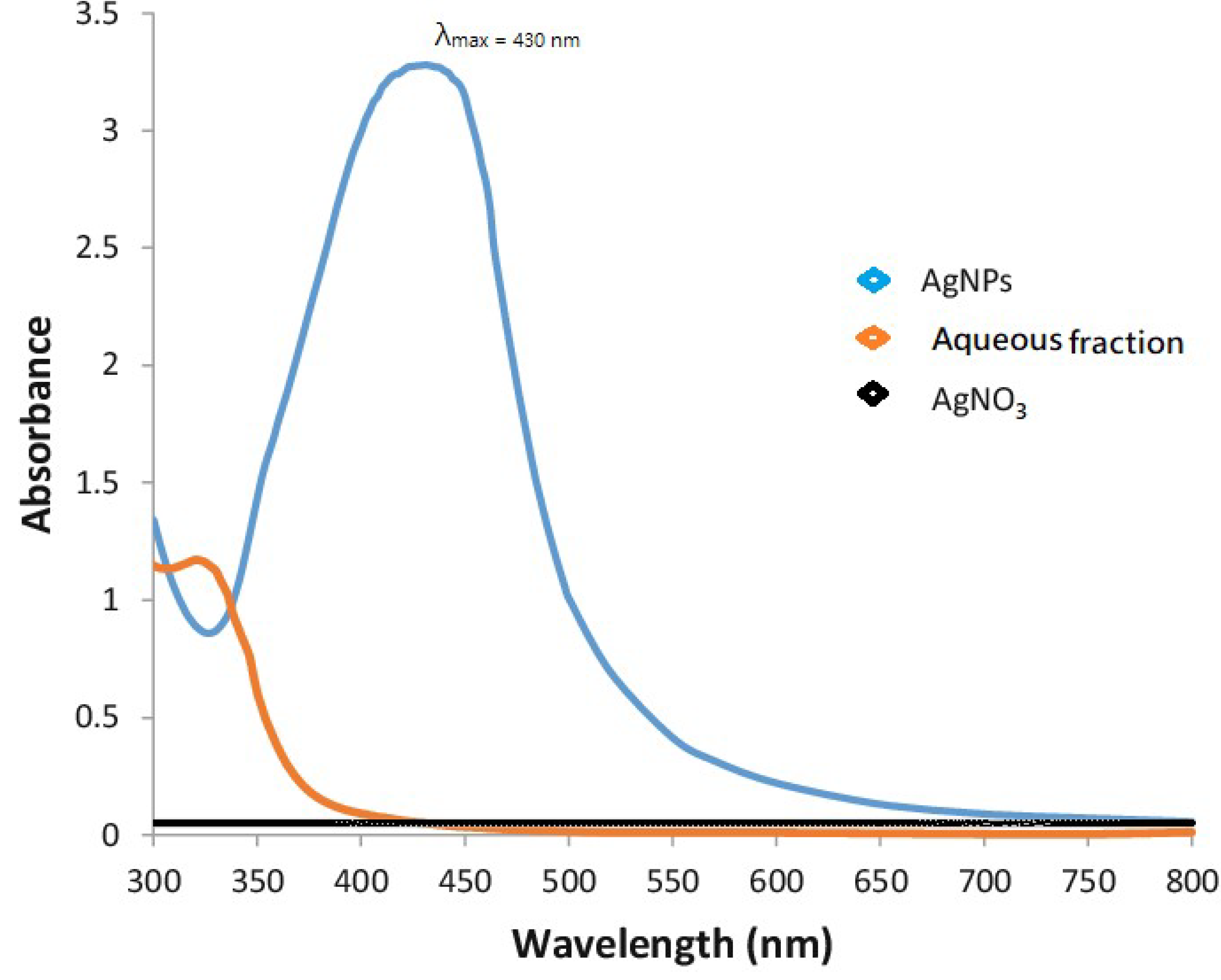
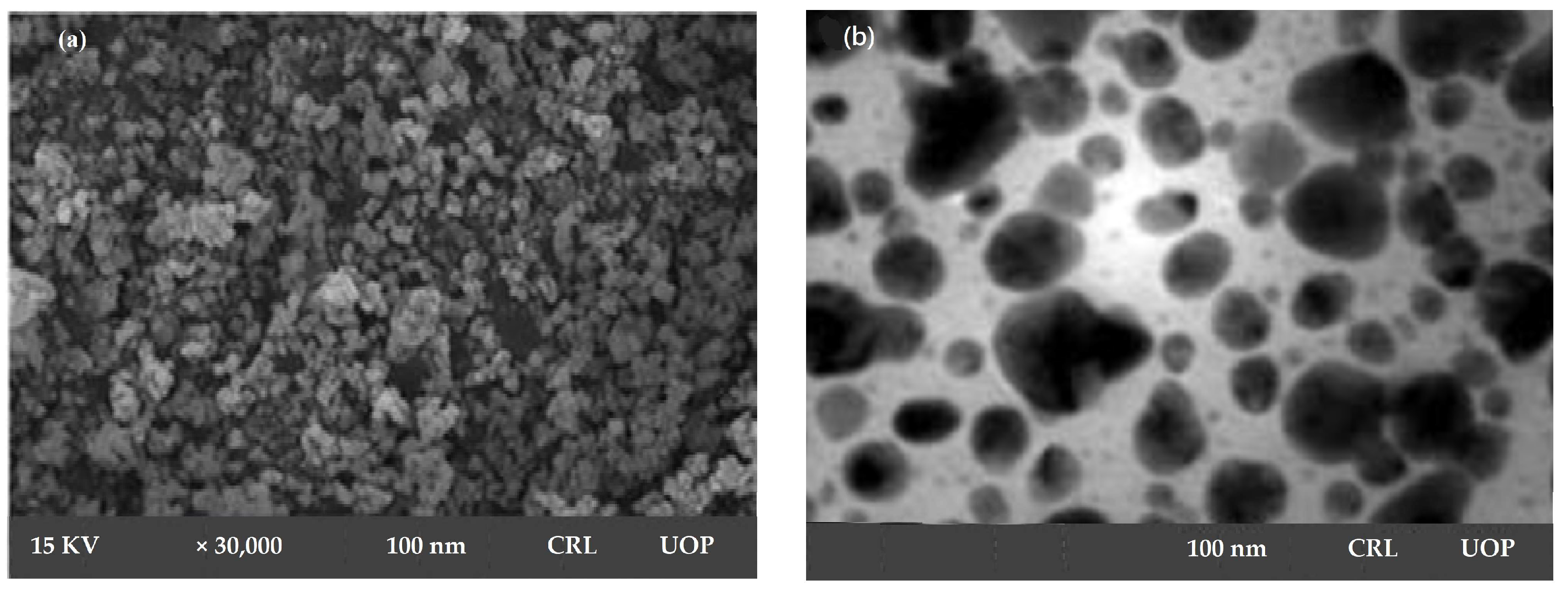

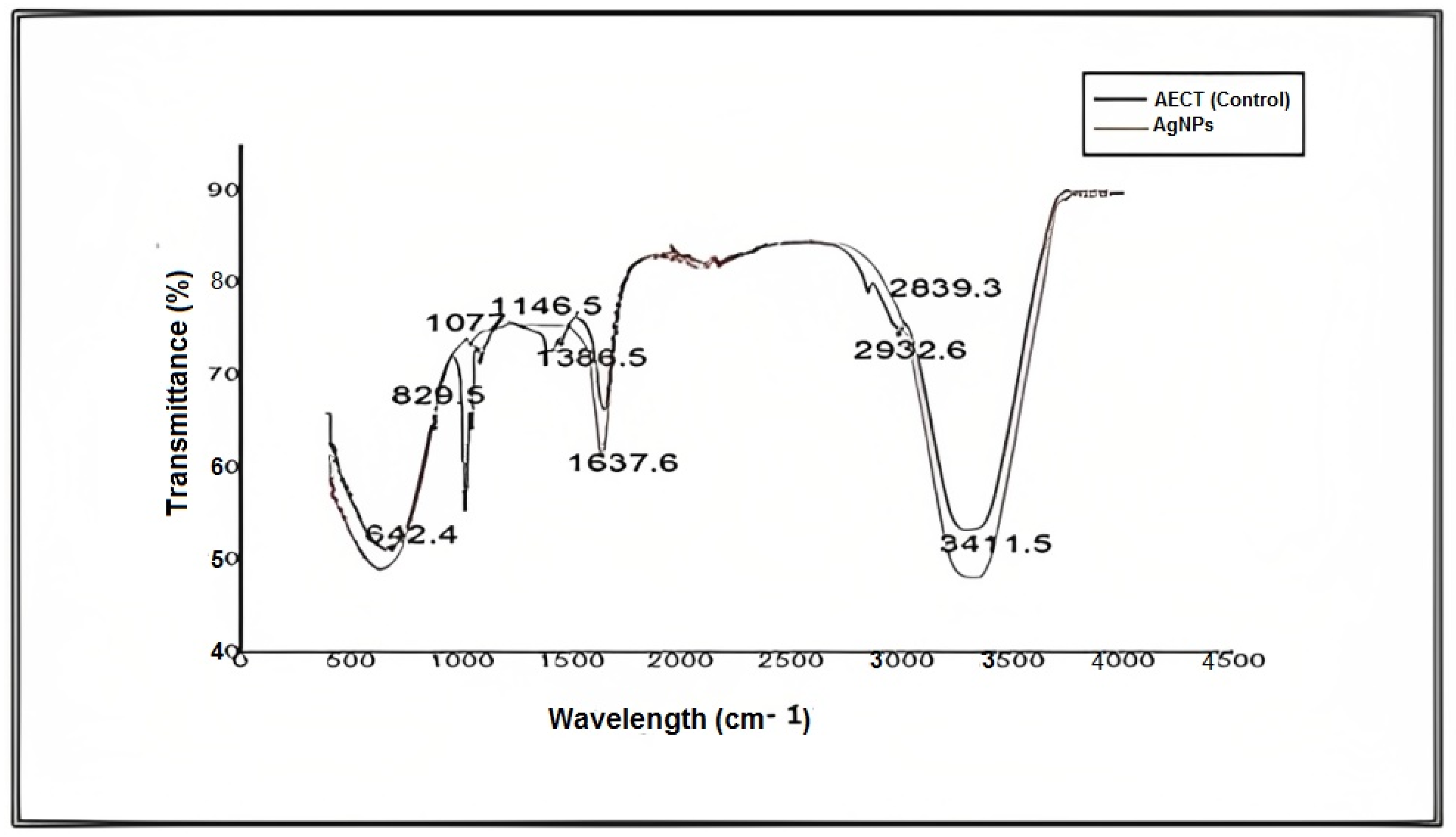

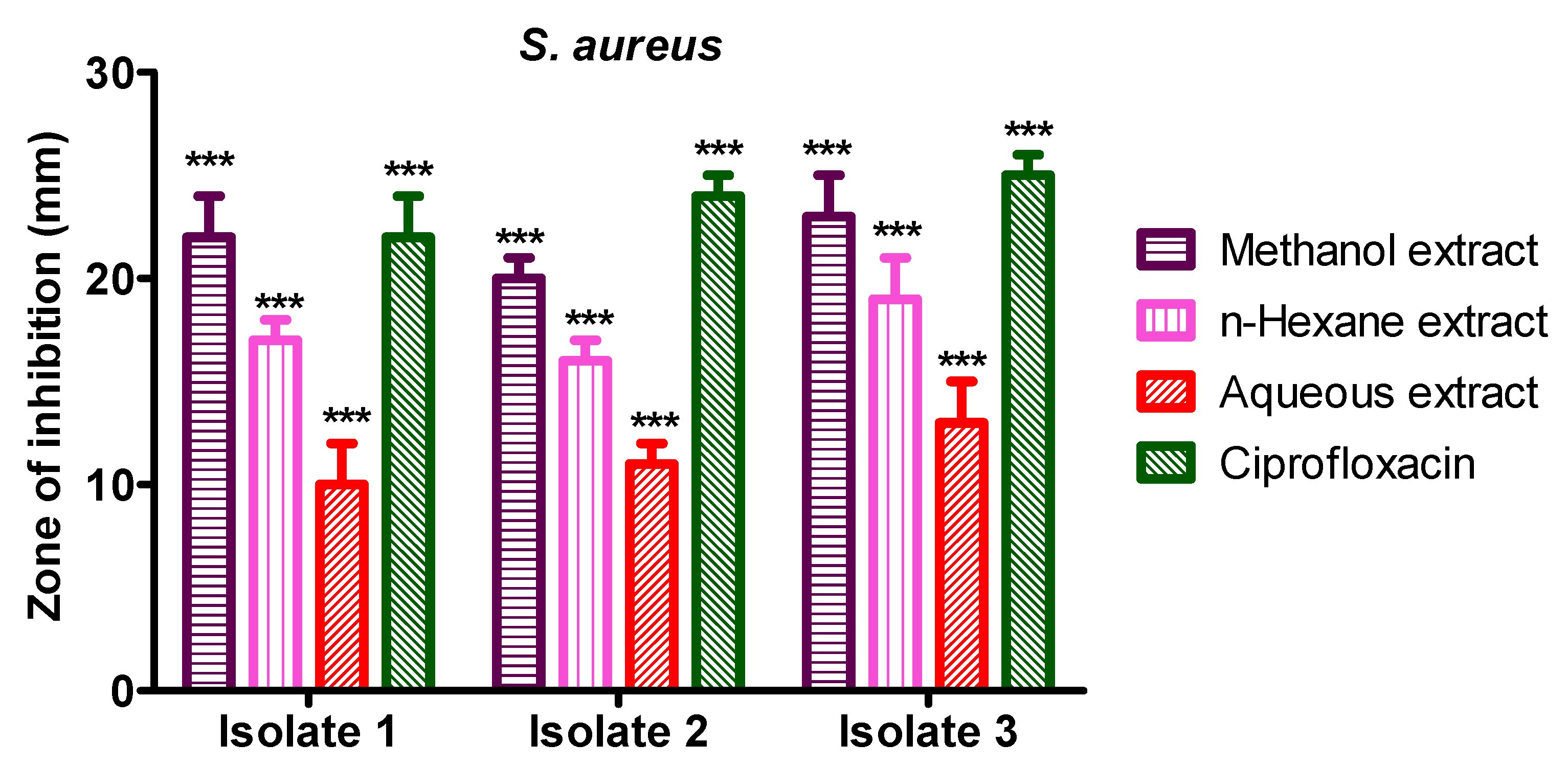
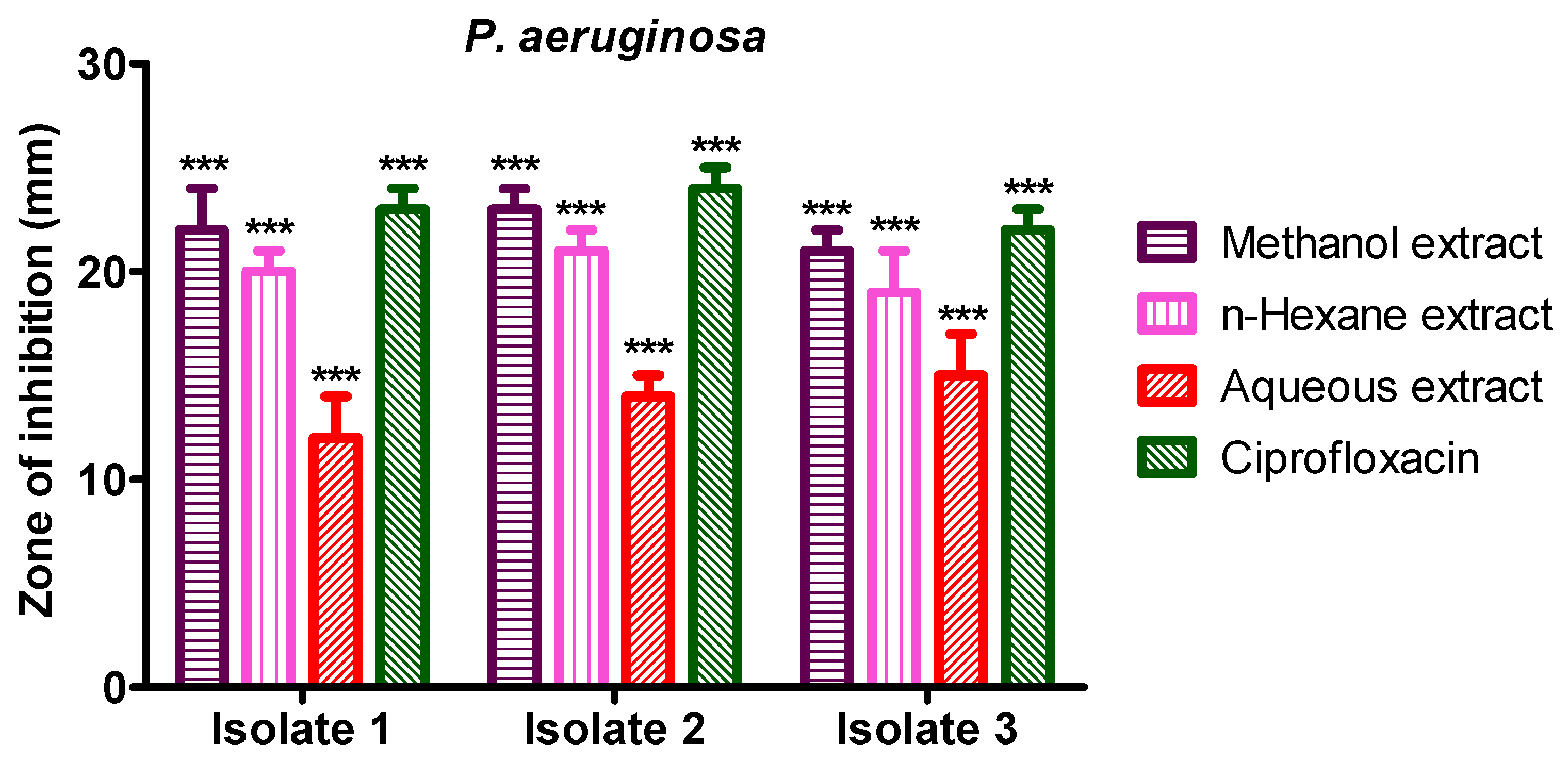
| Sr. No. | Identified Species | No. of Isolated Species (n) | Percentage |
|---|---|---|---|
| 1 | P. aeruginosa | 10 | 33.3% |
| 2 | S. aureus | 20 | 66.7% |
| Sr. No. | Culture Characteristics | Gram rxn | Cat | Lac | Dex | Cit | Ind | Urea | TSI Slant/Butt | Species Identified |
| 1 | Golden yellow, circular, soft, convex, shiny | + | + | AG | − | + | − | + | − | S. aureus |
| 2 | Greenish blue low convex shiny, rod | − | + | − | − | + | − | + | + | P. aeruginosa |
| Antibiotics Activity Measured in mm | S. aureus | P. aeruginosa | |
|---|---|---|---|
| Uncoated | 8 mm | 1 mm | |
| Tetracycline | AgNPs coated | 13 mm | 11 mm |
| Inc. % Potency | 62.5% | 100% | |
| Uncoated | 18 mm | 20 mm | |
| Levofloxacin | AgNPs coated | 25 mm | 23 mm |
| Inc. % Potency | 38.8% | 15% | |
| Uncoated | 8 mm | 6 mm | |
| Meropenem | AgNPs coated | 11 mm | 8 mm |
| Inc. % Potency | 37.5% | 33.3% | |
| Uncoated | 11 mm | 13 mm | |
| Gentamicin | AgNPs coated | 15 mm | 17 mm |
| Inc. % Potency | 36.3% | 30.7% | |
| Uncoated | 18 mm | 19 mm | |
| Ciprofloxacin | AgNPs coated | 22 mm | 22 mm |
| Inc. % Potency | 22.2% | 15.8% | |
| Uncoated | 21 mm | 20 mm | |
| Amikacin | AgNPs coated | 25 mm | 23 mm |
| Inc. % Potency | 19.0% | 15.0% | |
| Uncoated | 25 mm | 22 mm | |
| Imipenem | AgNPs coated | 38 mm | 26 mm |
| Inc. % Potency | 12.0% | 18.2% | |
Disclaimer/Publisher’s Note: The statements, opinions and data contained in all publications are solely those of the individual author(s) and contributor(s) and not of MDPI and/or the editor(s). MDPI and/or the editor(s) disclaim responsibility for any injury to people or property resulting from any ideas, methods, instructions or products referred to in the content. |
© 2023 by the authors. Licensee MDPI, Basel, Switzerland. This article is an open access article distributed under the terms and conditions of the Creative Commons Attribution (CC BY) license (https://creativecommons.org/licenses/by/4.0/).
Share and Cite
Rabbi, F.; Ahmad, I.; Nisar, A.; Rauf, A.; Alshammari, A.; Alharbi, M.; Suleria, H.A.R. Synthesis, Characterization, and Antibacterial Assessment (Synergism) of Silver Nanoparticles Prepared with Stem Bark Extract of Sterculia diversifolia. Crystals 2023, 13, 480. https://doi.org/10.3390/cryst13030480
Rabbi F, Ahmad I, Nisar A, Rauf A, Alshammari A, Alharbi M, Suleria HAR. Synthesis, Characterization, and Antibacterial Assessment (Synergism) of Silver Nanoparticles Prepared with Stem Bark Extract of Sterculia diversifolia. Crystals. 2023; 13(3):480. https://doi.org/10.3390/cryst13030480
Chicago/Turabian StyleRabbi, Fazle, Imad Ahmad, Amna Nisar, Abdur Rauf, Abdulrahman Alshammari, Metab Alharbi, and Hafiz Ansar Rasul Suleria. 2023. "Synthesis, Characterization, and Antibacterial Assessment (Synergism) of Silver Nanoparticles Prepared with Stem Bark Extract of Sterculia diversifolia" Crystals 13, no. 3: 480. https://doi.org/10.3390/cryst13030480
APA StyleRabbi, F., Ahmad, I., Nisar, A., Rauf, A., Alshammari, A., Alharbi, M., & Suleria, H. A. R. (2023). Synthesis, Characterization, and Antibacterial Assessment (Synergism) of Silver Nanoparticles Prepared with Stem Bark Extract of Sterculia diversifolia. Crystals, 13(3), 480. https://doi.org/10.3390/cryst13030480








